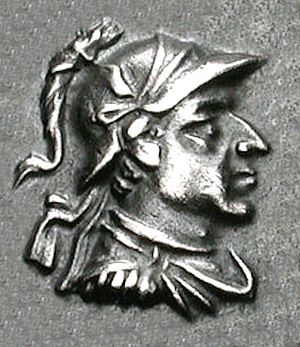Antialcidas
| Antialcidas Nikephoros "Victorious" | |
|---|---|
| Indo-Greek king | |

Portrait of Antialcidas.
|
|
| Reign | 130–120 BCE (R. C. Senior) 115–95 BCE (Boppearachchi) |
Antialcidas Nikephoros (Greek: Ἀντιαλκίδας ὁ Νικηφόρος; epithet means "the Victorious") was a Greek king of the Indo-Greek Kingdom, king of the Eucratid Dynasty, who reigned from his capital at Taxila. Bopearachchi has suggested that he ruled from ca. 115 to 95 BCE in the western parts of the Indo-Greek realms, whereas R. C. Senior places him around 130 to 120 BCE and also in eastern Punjab (which seems better supported by coin findings). Senior does however believe that he ruled in tandem with King Lysias.
Antialcidas may have been a relative of the Bactrian king Heliocles I, but ruled after the fall of the Bactrian kingdom. Several later kings may have been related to Antialcidas: Heliokles II, Amyntas, Diomedes and Hermaeus all struck coins with similar features.
Though there are few sources for the late Indo-Greek history, Antialcidas is known from an inscription left on a pillar (the Heliodorus pillar), which was erected by his ambassador Heliodorus at the court of the Shunga king Bhagabhadra at Vidisha, near Sanchi. It states that he was a devotee of Vishnu, the Hindu god.
A part of the inscriptions says:
Otherwise, Antialcidas is also known through his plentiful coins. He issued a number of bilingual Indian silver types: diademed, wearing a helmet with bull's horns or a flat kausia. He also appears throwing a spear. According to some interpretations (Grousset), the baby elephant may symbolize the Buddha Siddhartha Gautama, who took the shape of a small elephant to enter the womb of his mother Queen Maya, a scene often depicted in Greco-Buddhist art. In that case the coin scene would represent a victory of Buddhism. According to other interpretations the elephant was the symbol of the city of Taxila.
...
Wikipedia
